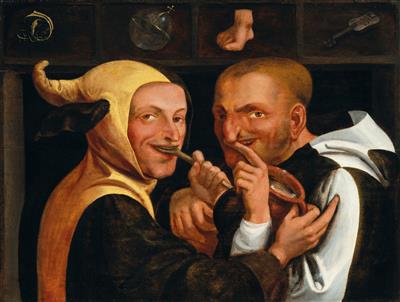Netherlandish School, 16th Century

‘De wereld voedt vele zotten’ - The world feeds many fools,
oil on panel, 36.5 x 48.5 cm, framed
Provenance:
sale, Musée Frans Claes ‘De Gulden Spoor’, Antwerp, 27 November –
1 December 1933, lot 187;
Collection of Bernardus Johannes Jansen Schellink (1902-1996), The Hague;
inherited by Mrs J. R. van Bergen, The Hague;
from whom acquired by the present owner
Literature:
S. Gudlaugsson, Kunsthistorische Mededeelingen, The Hague 1946, pp. 2-3, no. 1
The present panel is a vibrant example of the humorous, yet moralising, Flemish genre painting so sought-after by erudite collectors of the mid-16th century. In the current composition the symbols on the lintel above the two fools or ‘zotten’ denote a pictorial rebus, whose devices and hidden meaning were also employed by Frans Verbeeck (circa 1510-1570) upon the table in the foreground of his Mocking of The Human Follies, sold at Dorotheum 21 October 2014, lot 33. Inventories of the period show that pictures such as these were often hung in the dining rooms of the wealthy burghers in Mechelen and Antwerp. Despite the apparent vulgarity of the two Zotten, who leer at us as they gorge themselves on gruel, the picture is a conversation piece, its erudition delighting the informed viewer.
The gilded letter ‘D’ is De or ‘the’, whilst the crystal orb, usually seen in the hand of the Salvator Mundi represents the world or wereld. The voedt, or foot, is a pun on the Dutch for ‘feed’. Finally, the stringed vielle, is a play on vele meaning many, while the fools in their typical costume beneath complete the phrase De wereld voedt vele zotten, or ‘The world feeds many fools.’ This phrase should be seen in the context of the popular chambers of rhetoric or rederijkerskamers, which sprang up in Flemish towns in the period, staging a rich variety of satirical plays and poems that poked fun at human vices and follies.
Although popularised by Verbeeck and his contemporaries, the domestic setting of half-length close up figures arguably originates with Quentijn Massys (1466–1530), and his followers, including his son Jan Massijs (circa 1510-1575). The physiognomy and register of the zotten is echoed in Massijs’s ‘Vrolijk Gezelschap’ or Merry Company, conserved in the Kunsthistorisches Museum, Vienna. Different treatments of the same subject have been attributed on stylistic grounds to either Jan Massijs or Pieter Baltens, while other examples remain to be researched, such as the version (private collection, Vienna) listed in the RKD database under no. 122715.
Esperto: Damian Brenninkmeyer
 Damian Brenninkmeyer
Damian Brenninkmeyer
+43 1 515 60 403
oldmasters@dorotheum.com
10.11.2020 - 16:00
- Stima:
-
EUR 120.000,- a EUR 180.000,-
Netherlandish School, 16th Century
‘De wereld voedt vele zotten’ - The world feeds many fools,
oil on panel, 36.5 x 48.5 cm, framed
Provenance:
sale, Musée Frans Claes ‘De Gulden Spoor’, Antwerp, 27 November –
1 December 1933, lot 187;
Collection of Bernardus Johannes Jansen Schellink (1902-1996), The Hague;
inherited by Mrs J. R. van Bergen, The Hague;
from whom acquired by the present owner
Literature:
S. Gudlaugsson, Kunsthistorische Mededeelingen, The Hague 1946, pp. 2-3, no. 1
The present panel is a vibrant example of the humorous, yet moralising, Flemish genre painting so sought-after by erudite collectors of the mid-16th century. In the current composition the symbols on the lintel above the two fools or ‘zotten’ denote a pictorial rebus, whose devices and hidden meaning were also employed by Frans Verbeeck (circa 1510-1570) upon the table in the foreground of his Mocking of The Human Follies, sold at Dorotheum 21 October 2014, lot 33. Inventories of the period show that pictures such as these were often hung in the dining rooms of the wealthy burghers in Mechelen and Antwerp. Despite the apparent vulgarity of the two Zotten, who leer at us as they gorge themselves on gruel, the picture is a conversation piece, its erudition delighting the informed viewer.
The gilded letter ‘D’ is De or ‘the’, whilst the crystal orb, usually seen in the hand of the Salvator Mundi represents the world or wereld. The voedt, or foot, is a pun on the Dutch for ‘feed’. Finally, the stringed vielle, is a play on vele meaning many, while the fools in their typical costume beneath complete the phrase De wereld voedt vele zotten, or ‘The world feeds many fools.’ This phrase should be seen in the context of the popular chambers of rhetoric or rederijkerskamers, which sprang up in Flemish towns in the period, staging a rich variety of satirical plays and poems that poked fun at human vices and follies.
Although popularised by Verbeeck and his contemporaries, the domestic setting of half-length close up figures arguably originates with Quentijn Massys (1466–1530), and his followers, including his son Jan Massijs (circa 1510-1575). The physiognomy and register of the zotten is echoed in Massijs’s ‘Vrolijk Gezelschap’ or Merry Company, conserved in the Kunsthistorisches Museum, Vienna. Different treatments of the same subject have been attributed on stylistic grounds to either Jan Massijs or Pieter Baltens, while other examples remain to be researched, such as the version (private collection, Vienna) listed in the RKD database under no. 122715.
Esperto: Damian Brenninkmeyer
 Damian Brenninkmeyer
Damian Brenninkmeyer
+43 1 515 60 403
oldmasters@dorotheum.com
|
Hotline dell'acquirente
lun-ven: 10.00 - 17.00
old.masters@dorotheum.at +43 1 515 60 403 |
| Asta: | Dipinti antichi |
| Tipo d'asta: | Asta in sala con Live Bidding |
| Data: | 10.11.2020 - 16:00 |
| Luogo dell'asta: | Wien | Palais Dorotheum |
| Esposizione: | 04.11. - 10.11.2020 |
